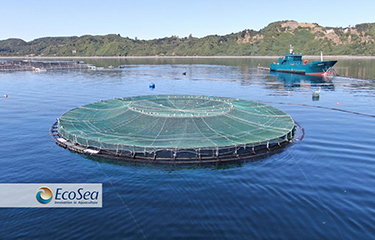Copper-alloy nets being trialed in Japanese aquaculture

EcoSeaTech LLC – the Osaka, Japan-based subsidiary of EcoSea Farming SpA, headquartered in Santiago, Chile – is trialing submersible cage systems using copper-alloy netting in Japan.
The parent company, EcoSea Farming, which has a decade of experience in making offshore net systems for various species around the world, utilizes UR30 copper alloy that is patented and produced for aquaculture use by Mitsubishi Materials Corporation. It has anti-fouling, anti-microbial, and anti-corrosion properties.
Copper curbs biofouling, such as adhesion of algae, sea moss, sea anemones, barnacles, and mollusks. When these materials accumulate, they can block the flow of water and reduce the oxygen level in the net pen, while increasing pathogens and parasites. Thus, preventing their accumulation helps reduce mortality and improves growth and feed conversion.
Nylon netting typically must be cleaned by divers about every seven months, but with copper-alloy netting, the frequency of cleaning can be significantly reduced. Even when cleaning is performed, removal is easy, as attachment is weaker. Since underwater work can be expensive and dangerous, reducing it is advantageous. Copper alloy is also stronger than nylon, so it helps prevent predators like sea lions from breaking into nets.
The EcoSea systems’ design and construction – featuring surface and submersible operation – provides structural integrity making it weatherproof as well as escape- and predator-proof. With contracted maintenance, EcoSea provides 10-year operational guarantee. At end of life, the netting is recyclable.
The drawbacks of copper alloy are cost and weight. As for cost, the longer product-life, reduced cleaning work, better fish health, and end-of-life recycle value of copper tends to offset the initial cost, according to the company.
EcoSea doesn’t just sell netting, but designs and sells large circular submersible cage systems for offshore use as well. The increased weight of copper means that flotation must be increased accordingly, however, in some situations, weight is a good thing as it keeps the net from losing its shape or tangling, especially in rough seas, the company said.
EcoSeaTech Business Development Manager Kyoko Nagai said the company’s system allows the cages to submerge smoothly to avoid rough offshore conditions such as high waves. The cages are also designed to accommodate automatic feeding systems and a mortality extraction system.
EcoSeaTech in Japan has been trialing an installation of round nets with a diameter of 20 meters in Kyushu.
“Since the Japanese government is promoting exports of buri [yellowtail], we think the production will increase. However as there are limited concessions available nearshore, offshore production can provide a viable solution, so EcoSeaTech plans to seize this opportunity,” Nagai said.
It has also designed new smaller square cage systems, such as 8x8 or 10x10 meters, to meet the site conditions of existing buri farmers. Four such cages are being installed at a site in Kyushu.
Photo courtesy of EcoseaTech/Ecosea Farming






Share